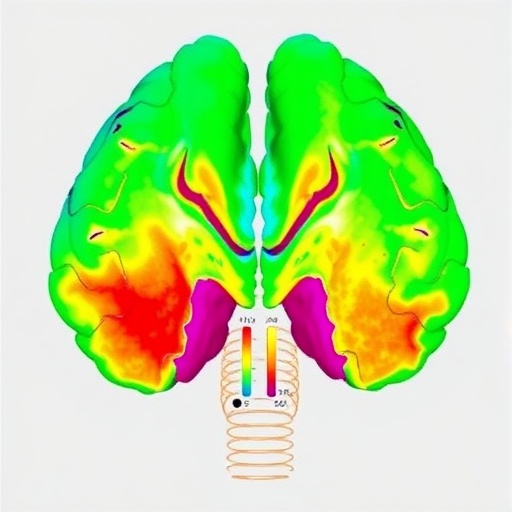Recent advancements in molecular biology have unveiled the profound influence that photoperiods—the varying lengths of day and night throughout the year—exert on physiological mechanisms in a variety of organisms. A pioneering study conducted by He et al. investigates this phenomenon through a detailed analysis of DNA methylation and gene expression in the hypothalamus of ewes. Their findings may pave the way for deeper insights into reproductive bioenergetics and seasonal breeding, a trait evident in many agricultural species.
In the realm of endocrinology, understanding how external environmental cues regulate internal homeostasis is critical. The hypothalamus serves as a central hub for integrating such signals and orchestrating endocrine responses, particularly those related to reproductive hormones. By exploring the DNA methylation patterns and gene expression profiles in the hypothalamus of ovariectomized ewes treated with estradiol, the study meticulously outlines the molecular modifications that occur in response to changing light conditions.
To begin with, the authors utilized a comprehensive approach that combined molecular biology techniques with carefully controlled experimental designs. By focusing on ovariectomized ewes, they created a stable hormonal background through estradiol supplementation, thereby isolating the effects of photoperiod changes. This methodology is critical as it allows researchers to eliminate confounding variables associated with natural cycles of estrus and examine pure hormonal responses to photoperiodic adjustments.
One of the intriguing aspects of the study is its investigation into DNA methylation—a key epigenetic modification that influences gene expression without altering the underlying DNA sequence. This modification plays a pivotal role in regulating developmental processes and responses to environmental cues. The researchers hypothesized that variations in day length would induce significant changes in the methylation patterns of genes involved in reproductive functions.
Throughout their analysis, He and colleagues observed remarkable shifts in DNA methylation levels correlated with the duration of light exposure. These modifications were not uniformly distributed but rather targeted specific genes that are crucial for the hypothalamic regulation of reproductive hormones. As the photoperiod lengthened, there was a notable alteration in the methylation status of genes linked with neuroendocrine signaling pathways, underpinning the idea that light is a powerful regulator of reproductive physiology.
The study also delved into gene expression changes alongside DNA methylation alterations. By employing RNA sequencing technology, the researchers cataloged a plethora of transcripts whose expression levels varied significantly with changes in photoperiod. Notably, genes associated with reproductive health, such as those involved in the synthesis and release of gonadotropin-releasing hormone (GnRH), showcased altered expression profiles reflective of the photoperiodic alterations.
Interestingly, the findings suggest that the interplay between DNA methylation and gene expression is multifaceted, with external stimuli, such as light, acting as primary regulators. This discovery has far-reaching implications, not only in understanding the reproductive adaptability of ewes but also in applying this knowledge to other domesticated species, potentially improving breeding programs through better synchronization with environmental signals.
Moreover, the study’s implication extends beyond the confines of animal science. The findings contribute to the broader discourse surrounding how climate change might disrupt natural photoperiods and, in turn, affect reproductive strategies in various species. As humans continue to alter landscapes and ecosystems, understanding these biological responses will be critical for the conservation of biodiversity and the sustainability of agricultural practices.
He et al.’s investigation into photoperiodic responsiveness also highlights the intricate relationship between epigenetics and environmental factors. Epigenetic mechanisms, including DNA methylation, offer a dynamic framework for organisms to adapt to fluctuations in their surroundings. These insights are particularly salient in an era where rapid environmental changes pose significant challenges to wildlife and domesticated species alike.
The results of the study are likely to provoke further research into the role that epigenetic changes play in the reproductive strategies of other species. For instance, the implications of this work could extend into poultry science, aquaculture, and even mammalian species conservation efforts—where understanding reproductive timing is crucial.
In summary, research by He et al. underscores the importance of photoperiodic signals in regulating reproductive mechanisms through complex molecular pathways involving DNA methylation and gene expression. This significant body of work not only advances our understanding of hypothalamic functions in hormone regulation but also serves as a foundation for future investigations aimed at addressing challenges within animal husbandry and species conservation in a changing world.
In a broader context, the study exemplifies the convergence of molecular biology, environmental science, and agricultural development, illustrating how interdisciplinary approaches can yield comprehensive insights into complex biological questions.
As we look ahead, the findings from this investigation are expected to inspire new methodologies in reproductive management and targeted breeding programs. By leveraging our understanding of epigenetic modifications and their responsiveness to environmental changes, we pave the way for innovative solutions that align agricultural practices with sustainable ecosystem management.
The future of agricultural productivity and biodiversity maintenance will undoubtedly depend on integrating these scientific insights into practice, ensuring that we remain adaptable and informed in the ways we interact with our environment.
In conclusion, the future of animal reproduction and agricultural practices may well ride on our ability to understand and manipulate the genetic and epigenetic underpinnings of photoperiod responsiveness.
Subject of Research: The effect of photoperiod on DNA methylation and gene expression in the hypothalamus of ovariectomized and estradiol-treated ewes.
Article Title: Photoperiodic responsiveness in the DNA methylation and gene expression in the hypothalamus of ovariectomized and estradiol-treated ewes.
Article References:
He, X., Di, R., Wang, X. et al. Photoperiodic responsiveness in the DNA methylation and gene expression in the hypothalamus of ovariectomized and estradiol-treated ewes.
BMC Genomics 26, 873 (2025). https://doi.org/10.1186/s12864-025-12066-y
Image Credits: AI Generated
DOI: 10.1186/s12864-025-12066-y
Keywords: DNA methylation, gene expression, photoperiod, hypothalamus, ovariectomized ewes, estradiol, reproductive physiology, epigenetics, environmental signals.




